Don't wanna be here? Send us removal request.
Text
Documentation - Ephemerality
My final project is a combination of an abstract musical piece that I composed and produced and Visuals I made in Touch Designer and Max.
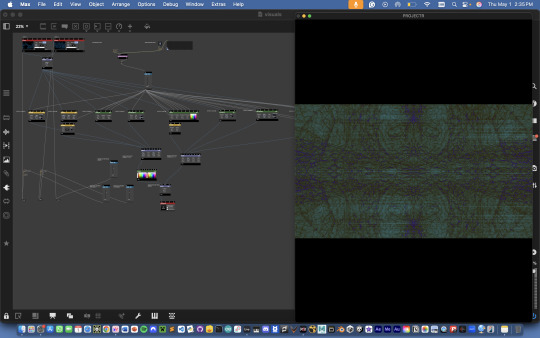
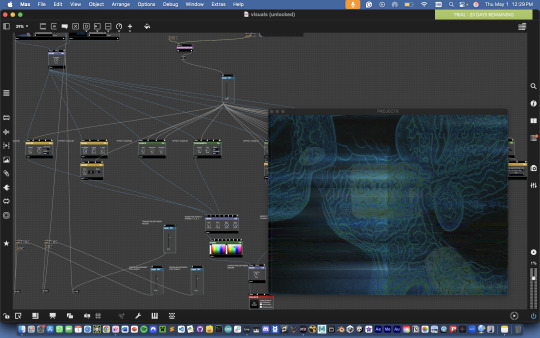
Final Video Link
Surrounding Video in brightspace post.

Initially, I wanted to make a different installation with eyes everywhere following the viewer or nature fluidity upon interaction and movement but I sort of combined the two ideas to make this effect in touch designer and use it to be audio interactive and VJing in Max. I write more about the project in the proposal but I also used ableton to make the beats and sounds as well as self recordings. And lastly, I made a controller from scratch using Arduino, mapping the buttons to my sounds.

0 notes
Text
Space Confined - Documentation
Like I said in my description, initially the project was supposed to be outer space in a jar but my projector failed me. Nevertheless, I have documented the entire process below
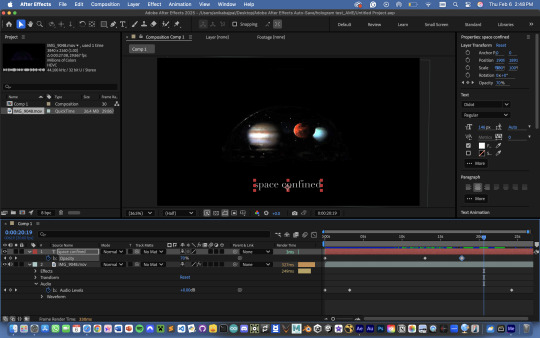
For the base of the animation, this is a work I have done that can be found on my website:

This was the set up for the projector but no signal was to be found: I used sparkly tulle from Michaels as well:


As I discerned that these were unusable without a working projector, i resorted to the plastic lid cup method:

I propped my laptop upside down in my bathroom and reflected part of my animation on to it to reflect outer space in a confined "glass", giving it that illusion.

I had a very fun time making this installation but I would really like to add more elements and be able to use a projector next time. :)
0 notes
Text
Dereality Documentation
https://docs.google.com/presentation/d/11zZGfK2ohxCnlKntgQZRf75KJOCu9w3aZpiAH3kCtow/edit?usp=sharing
0 notes
Text
The Confluence of Data & Art as Described by Whitelaw
We live in a world driven by data. It tracks our steps, curates our social media feeds, and shapes the ads we see. It feels natural that artists would start using data to tell stories about the world around us. But as Mitchell Whitelaw points out in his essay Art Against Information, data is not as straightforward as it seems. It can be a powerful medium, but it comes with its own set of challenges and responsibilities. His critique dives into how data is used in art, showing where it can fall short and where it can truly shine.
One of Whitelaw’s key points is that data is often mistaken for truth. On its own, data is raw: it is just a collection of facts, numbers, or text. It only becomes meaningful when someone interprets it, turning it into information. Whitelaw critiques artists who use data as if it is a neutral or objective reflection of reality. In truth, data is shaped by the people and systems that collect it.
One example that comes to mind is social media. Platforms like TikTok and Instagram collect data on what you like, watch, or comment on. This data feels impersonal, but it is used to feed algorithms that shape your entire online experience. These algorithms reinforce biases and often prioritize engagement over well-being. Artists who use data like this without questioning where it comes from or how it is shaped risk perpetuating the same issues.
Whitelaw also calls out how some artists treat data as mysterious or inherently insightful, as if it contains hidden truths waiting to be unlocked. While this approach can produce visually stunning work, it sometimes overlooks the bigger picture. Where did the data come from? What biases are baked into it? What stories are being left out? These are essential questions to consider.
Creating art from data is not easy. One of the biggest challenges is making something abstract feel relatable. Data can often seem cold or impersonal, like a spreadsheet of numbers. Without context or emotional connection, it can be hard for people to engage with it. I once saw an installation that used color gradients to represent climate data. While it was beautiful, it did not immediately convey the urgency of rising global temperatures. Artists working with data have to find ways to make their work resonate on a human level.
On the flip side, data offers incredible creative opportunities. It allows artists to explore massive, complex topics, things like global migration, economic inequality, or the spread of misinformation, in ways that traditional media cannot. Neil Halloran’s The Fallen of World War II is a perfect example. It visualizes the human cost of war by layering individual stories over stark statistics. This combination of data and narrative creates a deeply emotional experience that lingers long after you watch it. I remember seeing this in my AP US History class in high school a few years back and thought it was very impressive.
youtube
There is also a technical challenge. Working with data often requires coding, data visualization tools, and even machine learning. This can be intimidating, but it also pushes artists to collaborate with data scientists or technologists, creating opportunities for innovation and new perspectives. From personal experience, working with data can be daunting when creating art. I, too, must push myself to explore the medium of combining art and data.
One of the most exciting things about data art is its ability to change how we see the world. Whitelaw highlights projects like The Dumpster, which visualizes teenage breakups through blog posts. At first, it seems lighthearted, but it quickly raises deeper questions about how we share personal experiences online and how these stories connect us. Similarly, Brad Borevitz’s State of the Union uses political speeches to show how language and priorities have shifted over time. By visualizing these patterns, Borevitz invites audiences to think critically about the political rhetoric shaping their lives.
Data art can also expose hidden injustices. One project that stood out to me is Tega Brain’s Hacking the Flow of Data. It uses data visualization to highlight environmental and social inequalities, making invisible systems of oppression visible. This kind of work not only informs but also challenges viewers to confront uncomfortable truths and consider their role in creating change.
Whitelaw’s essay is a reminder that data is never just data; it is shaped by people, processes, and systems. Artists who work with data have a unique opportunity to uncover hidden stories and inspire reflection. But with this opportunity comes responsibility. To make meaningful work, artists need to think critically about where their data comes from and how it is used. When done thoughtfully, data art can go beyond aesthetics. It can become a powerful tool for understanding the world and sparking conversations about the issues that matter most.
0 notes
Text
Final Project Idea
Although a specific art piece doesn’t inspire my idea, it proposes an answer to a pressing question: as a society, we are increasingly distant from human touch and connection. As technology evolves, we lose sight of authenticity in our daily lives. Aside from the rise of AI and its integration into society, one thing I’ve noticed that has always bothered me is the concept of “fast media.” Apps like TikTok and Instagram now use algorithms to create quick dopamine hits, keeping people hooked to generate profit. They want to keep people chained to the same content, diminishing creativity while profiting from everyone’s time. It’s sickening: it’s an addiction, a cycle, a loop that we as a society need to wake up from before our sense of self is lost forever.
I want to create a gallery of real sensations and experiences: an interactive, immersive installation that utilizes music, props, walls, motion graphics, and software like TouchDesigner, After Effects, Motive, and Unreal Engine to create realistic visuals. This will allow people to pause, immerse themselves, and reflect on authentic content that doesn’t serve capitalist intentions. Visitors will put on headphones, walk to different parts of a room, and take in visuals that address these issues.
For one of my prompts, I want to showcase a visual I created versus one AI generated: How far are we from reality?
Another piece will address nature and climate change: Why don’t more people care about the trees, the mountains, the forests, the very things that give us life?
In exploring relationships and connection, I want to present a poem about emotions, examining how society often suppresses feelings, glorifying mystery and indifference.
Addressing these topics as individual pieces would be incredible. I strive for my work to serve as a vessel through which people can experience, reflect on, and connect with their own lives.
My goal is to tell stories that resonate with people, creating relatable, soul-touching content that brings peace to the mind and captures the beautiful essence of life, reminding people of reality and all that’s real. That’s what I aim to do. I want to do it to the best of my abilities across all my projects. I want my audience to be so immersed that they momentarily forget everything else, just as I’ve been captivated by the films, media, installations, and projects I’ve experienced.
Creating a world for someone to immerse in, even if not their own, is something uniquely special, and I’m determined to make that happen. Money is only a means to get by; it’s not my main focus. I want to capture life’s essence and reflect it to people who genuinely care, who will listen and take it in. I believe that aesthetics make life worth living. Romanticizing even the most minor details is beautiful, but I also want my work to challenge people’s sense of reality, whether they experience it alone or with others.
I went on a rant, but I have many goals I wish to accomplish.
Title: Our Senses in a Fake Reality (to be decided)
What is Real Reality? Our real experiences, the things we see with our own eyes and the sensations we feel, not what others impose on us. I want people to relate their own experiences and thoughts to my work. Fake reality is what we consume daily, what 90% of us are exposed to. Social media, news, television… all this fast-paced media nonsense. Why don’t people stop to think anymore, to enjoy the moment and sensory details? Everything feels so overloaded.
0 notes
Text
Objectively Summarizing Metaverse Identity
In his foreword, Daniel Dobrygowski paints the metaverse as the next evolution of the internet. In this world, digital and physical realities come together seamlessly, creating shared spaces where people can interact as if there were no screens between them.
This new "social internet" is powered by technological advancements, especially artificial intelligence, which could bring the metaverse to life faster than we’d imagined.
But beyond all the hype, there’s a deeper purpose here: to reshape how we interact, create, and others online in a way that feels safe, inclusive, and empowering.
The question of " identity " is a crucial theme in the metaverse, and the World Economic Forum is exploring it closely.
What does it mean to represent ourselves in a virtual world?
How do we ensure our privacy is respected when everything, from our online behaviors to digital avatars, is connected?
With the launch of the Defining and Building the Metaverse Initiative, the Forum is bringing together voices from across industries to ensure that as the metaverse grows, it does so in a way that serves everyone, not just a select few.
This initiative focuses on two main goals: creating a solid framework for governance and working toward the social and economic benefits a well-built metaverse could bring.
To make this vision a reality, the initiative dives into the different aspects of identity in the metaverse. This includes representation (how we choose to appear, whether through avatars or digital images), data (the digital fingerprints we leave behind), and identification (our “ID” in the virtual world).
These layers matter because they shape how we interact, express ourselves, and build relationships online. In short, identity is no longer just a profile picture; it’s an entire, layered experience that reflects and protects who we are.
For the metaverse to be a safe and welcoming space, it must consider more than just the technology. It needs to respect diversity, avoid biases, and allow people to represent themselves in a way that feels true to who they are, both culturally and personally.
Privacy and security are crucial to building trust, and the Forum emphasizes working with a wide range of stakeholders, from tech innovators to policymakers, to ensure this.
Responsible data practices will be essential to prevent data misuse or digital profiling, and educating people on their rights and safety in this new space will be critical, especially for vulnerable populations like children.
In this journey to build a fair and open metaverse, there’s also a focus on empathy and community. The World Economic Forum believes that a successful metaverse will be one where we feel a sense of belonging, where human-first values are at the core, and where all users, not just digital natives, can participate safely and thoroughly.
The report is a call to action, inviting everyone, from companies and educators to governments, to build a digital future prioritizing humanity. In doing so, the metaverse could become a virtual playground that amplifies equality, creativity, and meaningful connections.
0 notes
Text
Avatar Reflections
Reading Beth Coleman’s ideas in Hello Avatar made me realize that avatars are more than just fun digital copycat characters. They’re part of how we explore and express who we are (or aren’t) in online spaces. Coleman dives into how avatars aren’t simply “us but a blend of our choices influenced by technology and social norms."
For me, setting up avatars that resemble my appearance is kind of satisfying; it’s fun to see a mini version of myself in a way. But I never feel that they fully capture who I am? I’m hesitant about making these avatars act like me because, honestly, I prefer my digital self to be more distant, maybe even impersonal and I have noticed this pattern with my fellow peers online.
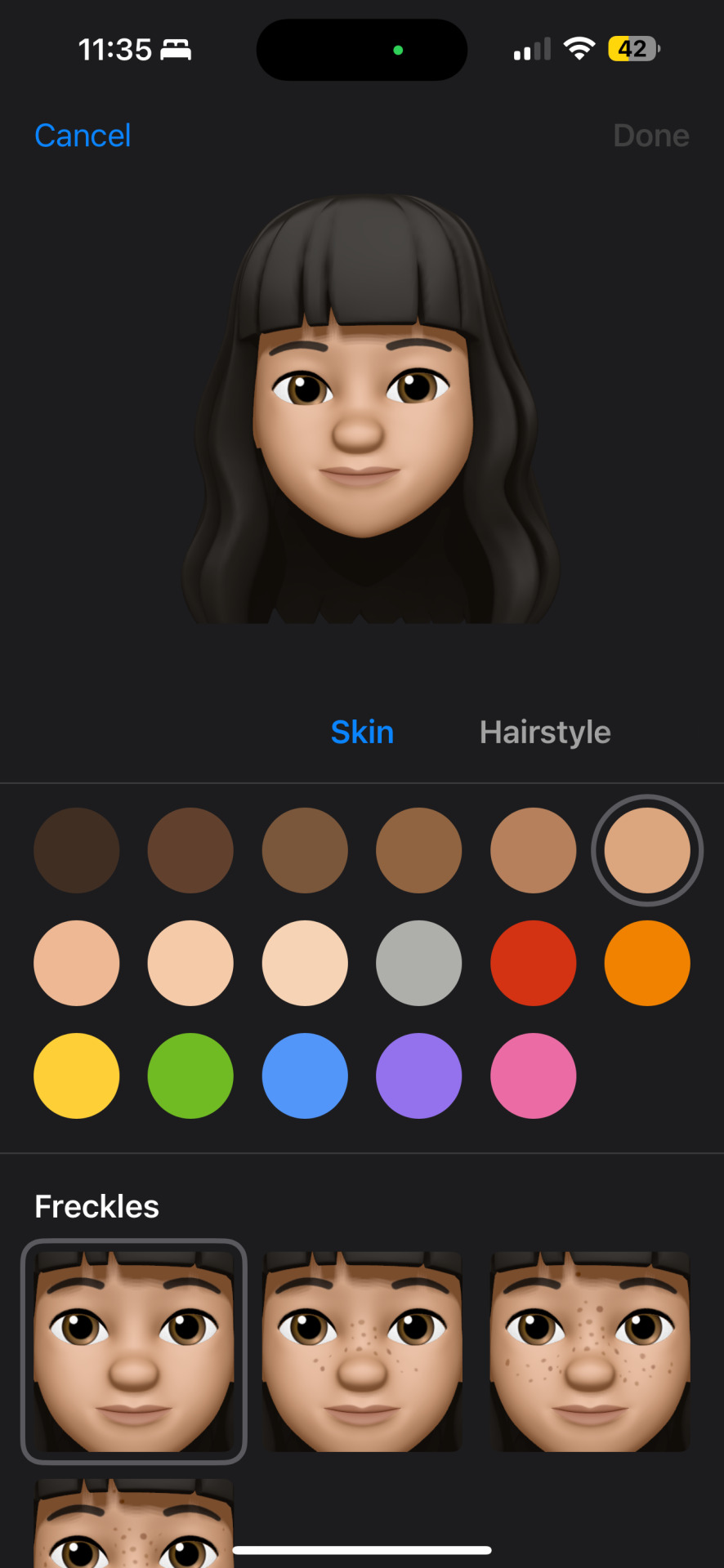
When I think about my online identity, it’s mostly appearance-focused. Sure, I’ll customize an avatar to look like me, but I rarely use it as a reflection of my behavior or personality.
Coleman calls avatars “performative” because they’re tools for interacting and showing different sides of ourselves, but I find my avatars pretty passive. They’re more like "placeholders", showing my presence on a platform without capturing how I communicate or connect with people.
But I don't think this necessarily creates a disconnect between my digital self and my authentic self, where I’m more direct and expressive.
One aspect Coleman mentions that resonates with me is the idea of avatars offering us the freedom to explore or reinvent our identity. For many, avatars are about breaking boundaries, maybe experimenting with personality traits they don’t feel comfortable showing offline, and I feel as if it truly depends on how you use these avatars across different platforms.
For example, in gaming applications like Mario Kart, Minecraft, or any Nintendo game, choosing an avatar is so fun and let's you explore a different personality through those digital environments.
But, they feel limiting instead of freeing on social media. They’re fun to customize, but the design options don’t reflect my true personality or how I think. I have a memoji, a bitmoji and an Instagram avatar but again, I never use them.

I enjoy the process of creating characters and 3D modeling—exploring forms and personalities outside myself—but using these digital representations to express my own identity feels restrictive.
Then, there’s the broader connection across online networks. My avatars on different platforms don’t actively interact; they’re part of a larger digital landscape, but mainly in the background, like little digital stamps with my appearance but not my personality. Mine stay unused, unlike people who use avatars to connect across apps or communities. I don’t feel like they’re tools for communication; they’re just visuals without a purpose.
Reflecting on Coleman’s work makes me wonder what role these avatars actually play in my online identity. They’re there as visual markers, but they’re not me. They might look like me, but they don’t act like me or feel like me. In a way, this disconnect highlights how different my online and real identities are: my real self is animated and expressive, while my digital avatars are static, non-communicative.
Coleman’s insights give me a new perspective. Avatars offer us a way to explore identity, but for me, they feel incomplete. Again, they’re almost like placeholders that reflect some aspects of me but miss the deeper connection I’d want.

0 notes
Text
Discovering Infrastructure Around In the City
Over the weekend, I went around campus, observed various buildings, and noticed the number of surveillance systems in place.

I noticed this building was HEAVILY placed with surveillance cameras.

Multiple wires connected each camera, which was interesting. As someone unfamiliar with these types of cameras' technical designs and functions, I was surprised to see wires placed outwardly. Even then, I'm sure many people don't notice it as they match the color of the building.

I spotted at least seven cameras covering this building alone. This begs the question: Why is it so heavily monitored in the first place?

Another pair of cameras I spotted, this time, on the building opposite the first one.
Burrington’s book made me more aware of the physical infrastructure behind the Internet, but it also made me question the systems taken for granted. Do people even have the right to record pedestrians just walking by? And if they do, what’s being done with that footage? How is it used, and who controls it? It’s strange to think about how much data is being collected from us without our knowledge or consent.
Similarly, she also discusses how the same fiber-optic cables keep us connected to power surveillance networks, showing that being "online" isn’t just about what we do on our devices. It’s about how we’re constantly being watched, even in physical spaces we consider public.
Noticing all these cameras made me rethink what it means to be "connected" in today’s world. We often think of being online as something we do on our own, but what about when we’re being monitored without even realizing it? It’s hard not to wonder—who has the right to that data, and where do we draw the line between safety and privacy?
0 notes
Text
Networks of New York - "what we turn a blind eye on"
Ingrid Burrington’s Networks of New York is one of those books that makes you see the world differently. Most of us move through cities without giving much thought to the colored markings on the streets or the cabinets and poles scattered around. But these overlooked features are actually the backbone of the internet—"fiber-optic cables, power lines, and telecom infrastructure" that keep us all connected.
What really stands out in this novel is how she makes something so complex feel accessible. She points out different symbols we walk past every day on the streets: "Red marks electricity, while orange marks communications lines, the very fiber cables that power the internet.” Suddenly, you start to notice reading secret codes of sorts and seeing the physical traces of our digital lives everywhere.
But the book goes beyond just pointing out what’s beneath our feet. Burrington raises some critical questions about control and access. Most of this infrastructure isn’t publicly owned—it’s controlled by private companies, which is a very important detail. This leads to concerns about who gets access and how our data is managed. She makes an unsettling point when she says, “The same fiber-optic cables that power the internet also power government surveillance,” which really makes you stop and think about the terms we’ve accepted for the convenience of constant connectivity.
I think about how many of us are fooled by the deception of terms of agreements on various apps on our devices: for the sake of convenience, we press agree and never really question what data they require of us and what rights they hold over it.
Reading this, I couldn’t help but wonder: What does it mean for the future of the Internet if its infrastructure is primarily private? Burrington’s book is a wake-up call, reminding us that what we take for granted as the "invisible" internet is very real and all around us—and we need to pay attention. I'm also wondering if the government publicly owned infrastructure, and how safe would our data be even then?
0 notes
Text
Technology Shaping Our World
In general, I think these readings are really interesting because they open people's eyes to the hidden side of the Internet’s infrastructure—things we don’t think about but rely on daily.
One example that really stood out was how cell towers are disguised as trees or flagpoles, blending into the environment so we hardly notice them. It's a powerful indicator that no matter how big or small, technology is always around us, inevitably affecting our lives in small or big ways. It also makes me realize how disconnected we are from the physical systems that power our digital world because people don't usually think about it. Strangely, these towers, essential for our mobile phones and communication, are designed to look like part of the landscape, almost as if we're not supposed to notice them. It's also interesting how they look practically aesthetic to the terrain when playing into the landscapes.
Another interesting story from the readings was the party line in rural New Zealand, where one telephone line served an entire community. Back then, technology was something everyone shared and understood in terms of the physicality of it. The whole neighborhood was connected by a single system, and there was a sense of trust in how it worked. Today, technology has evolved so much that we don’t need to think about it—it just works, and we rarely stop to question how or why. This shift from shared, visible infrastructure to invisible networks highlights how far removed we’ve become from understanding the systems that make our lives run smoothly. Still, I think we should advance cautiously because we will soon have challenges differentiating between what technologies are humans and which are not.
Looking ahead to Web 3.0, I wonder if this trend of hiding technology will continue. In the last class, we discussed our previous reading about the ideal version of the Internet, free from governmental control. With more decentralization and increased privacy concerns, will the Internet become even more invisible? Right now, a clear understanding of how these systems work and who controls them is missing. It’s easy to forget that these invisible networks impact everything from privacy to data ownership, and that can be risky if we stay too disconnected from the process. Governmental laws also come into play concerning the internet, which most of society does not grasp. Is our data really private?
Both readings made me think about how important it is to make these hidden infrastructures more transparent. I want to explore this more—how do we stay connected to the very tools that connect us? If we pay attention to the physical and digital systems that shape our world, we might retain the ability to hold companies and governments accountable.
0 notes
Text
Conscious Roots - Documentation
At first, approaching this project was challenging because most of the artwork referenced in class didn't resonate with my art practices. At the same time, I was also having trouble finding my voice in expressing my identity and culture in my art.
Amelia Winger-Bearskin's (https://whitney.org/media/55115) work struck a chord within me because of the stunning visuals she generated with computer code in her poetic writing to express her cultural roots; it composed a compelling piece.
One of my primary specialty skills in my artwork has always been motion graphic design and visual storytelling, so I wanted to take this project as an opportunity to further enrich that skill.
Above is a Pinterest board I have been making for a while of dream visual installation projects I would like to create: I wanted to base this project on the same vibes.
Incorporating aspects of my culture and religion, especially as someone who came from Indian roots and was raised in America, was confusing to portray in my work. I started by making a collage mood board of visuals that initially inspired me.
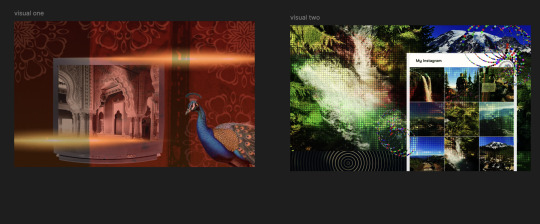
I knew I wanted to go for a retro vibe and reflect on old technology from my childhood. I also knew I wanted to utilize After Effects for the project, and I got to work on my first draft. This project was significantly "build as you go," which has been the case for my previous projects.
Phosphenes is also a project that inspired me to make Conscious Roots, which was more of a final "short film" with images that I utilized from my life.
My process included finding old images from my childhood and creating effects and elements using After Effects to showcase old technology.


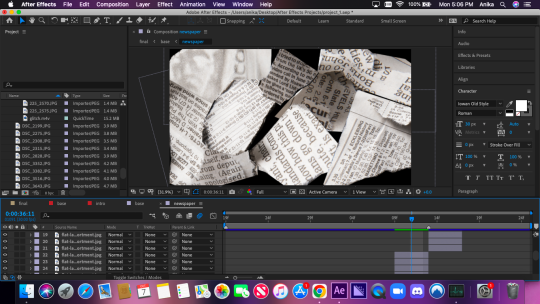
Below is a Dropbox folder containing old images from our family Canon DSLR Camera.

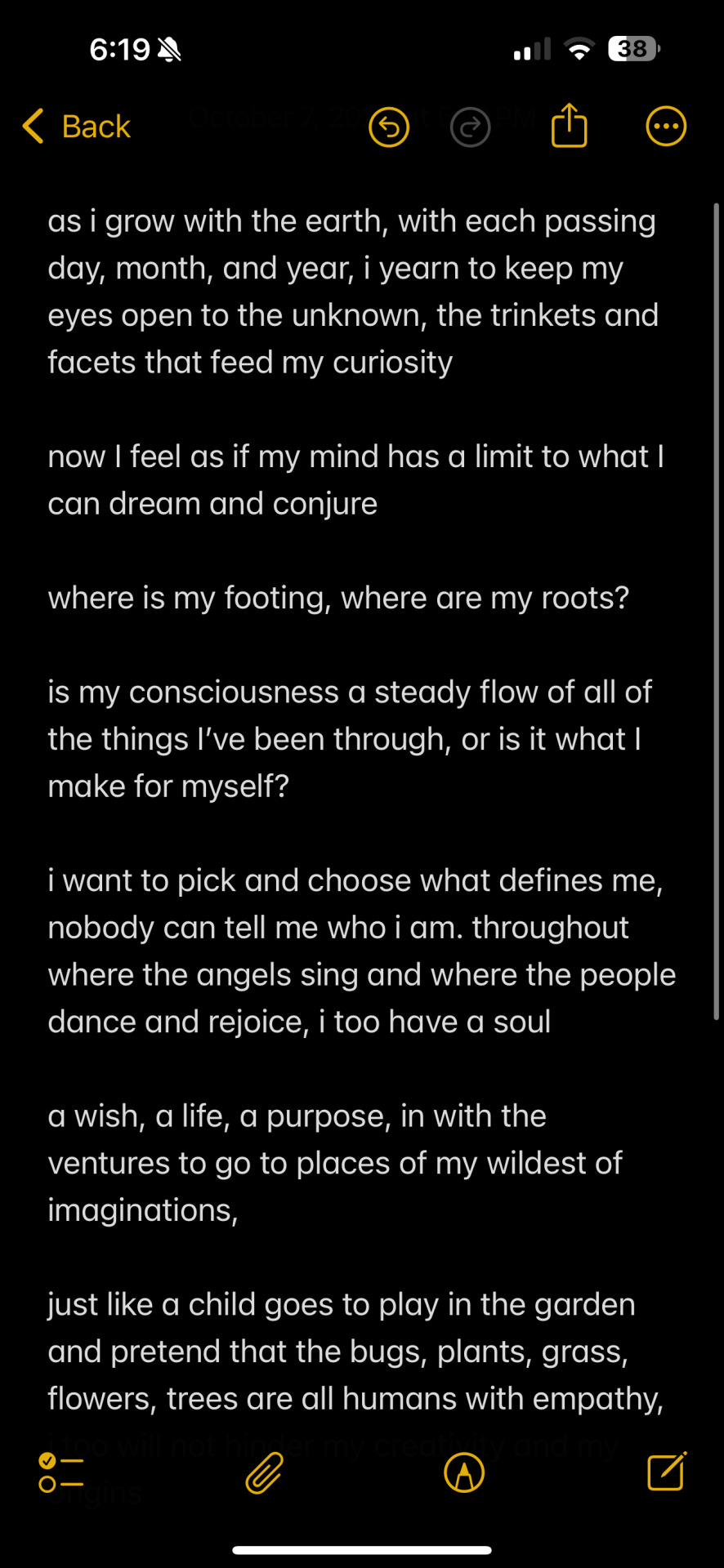
As for the texts I wanted to include, I brainstormed ideas on my notes app as someone who loves writing constantly. I wrote down whatever inspired me by Amelia's work.
To cap it off, I really went in with the intention of bringing nostalgia to its viewers. Conscious Roots invokes a more profound feeling of sonder in one’s life and asks the audience to reflect on “simpler times” and how the events of their lives made them who they are today.
I hope to reiterate this version of Conscious Roots as longer and more advanced in motion graphic techniques. I would also like to convert it into a more physical installation to showcase to viewers.
0 notes
Text
A Response to A Free Internet
Was it a surprise to me? Not really. The development of the internet, from Vannevar Bush’s vision of an automated library to the ARPANET's launch in 1969, has always seemed like a natural evolution. These early ideas shaped the way we think about the digital world today, but seeing how the internet has exploded into what it is now—millions of websites, endless streams of data—feels like a familiar part of our everyday lives. It’s easy to forget just how groundbreaking those early steps were, but they laid the foundation for everything we rely on today.
Do I see this as part of my history? Definitely. The internet has become such a huge part of how we interact, work, and live. It’s hard to imagine life without it, and knowing the history behind it makes it feel more personal. Those early pioneers weren’t just creating technology; they were imagining a new way for people to connect and share ideas across the world. In that sense, yes, this is my history, because it’s the backbone of how we experience the world now.
When it comes to John Perry Barlow’s "Declaration of the Independence of Cyberspace," his words are inspiring. He envisioned the internet as a space beyond the reach of governments, a place where freedom reigns. While I agree with his vision, things have changed. Governments do regulate parts of the internet now. But even today, the internet still carries that spirit of freedom, where people can express themselves, share ideas, and connect in ways that transcend borders. His message still feels relevant, even if the reality is a little more complicated.
0 notes
Text
Exhibition Reflection
In October 2023, I attended Refik Anadol’s Unsupervised exhibit at MoMA, and while it’s not a current show anymore, it has stuck with me. This exhibition conflicted me as someone who’s always been against AI in art. I’ve always approached my art by creating everything from scratch—whether through 3D software like Autodesk Maya or Blender or coding in p5.js. For me, manually crafting each piece is what makes it truly mine. That’s why generative art, where AI plays such a huge role, feels like a completely different world—one I’ve never fully explored. Still, seeing Unsupervised made me stop and think.
What really captured my attention was the visual fluidity of the exhibition—the way the colors shifted, the particle effects flowed, and the transitions were almost hypnotic. As someone who’s into motion graphics and loves working with particle simulators, I found myself engrossed by the smoothness of the visuals. I even took a video because I couldn’t get over how seamless everything looked. I had a feeling AI was responsible for much of that, but part of me thought, "Well, putting together visuals like this isn't too difficult if you know your way around certain tools." Yet, seeing the sheer scale and complexity made me realize that this was more than just a collection of pre-made visuals—it was something alive, evolving in real time.
The exhibit had this calming yet awe-inspiring vibe. You step into the main room as soon as you enter the museum, and suddenly, you're surrounded by this massive, constantly changing screen. The curation heightened the experience—isolating you from work made you feel like you were part of the piece flowing with the colors and patterns. It was easy to forget everything else and lose yourself in the visuals. The context of the space mattered a lot; it allowed the AI-generated transitions to take center stage in a way that made them feel more personal and immersive.
Reading the wall text helped me get a better understanding of how the exhibit was made. I learned that the AI behind Unsupervised was trained on millions of images and pieces from MoMA’s collection, which made it all the more meaningful. This wasn’t just random data being spat out—it was art based on art. That added a new dimension for me, but it also made me wrestle with a bigger question: Should we be okay with AI playing such a big role in creating art?
Even though Unsupervised was undeniably beautiful, I’m still torn. I’ve always believed that art should come from the artist, their hands, and their mind. AI is making producing these works more accessible, but where’s the line? How much of the human element are we willing to sacrifice for technology? AI in art feels inevitable now, but I think there has to be a balance—a limit to how much we rely on it. This exhibition opened my eyes to the possibilities AI offers, but it also reminded me that there’s something irreplaceable about the human touch in art, something that AI can’t replicate.

0 notes
Text
Balancing Creativity & Technology
In both bell hooks’ Teaching Critical Thinking and Olia Lialina’s Not Art & Tech, two important people offer their unique perspectives on the relationship between “creative practices” and “critical thinking”. hooks highlights how essential critical thinking is, not just for education but for meaningful creative expression and overall artwork. She believes that questioning the world around us—whether that’s societal norms or structures of power—is a necessary part of creating art that truly resonates and inspires. Thinking outside of the box and also outside of set ideals and exploring every facet of our world is a key aspect that she highlights throughout her writing. For hooks, art isn’t just about aesthetics or self-expression; it’s a way to push boundaries and challenge the so-called “status quo”.
Lialina, on the other hand, delves into the modern art world, particularly this terminology we see quite often, “the intersection of art & technology”. She critiques how new media art can sometimes overuse technology, focus more on the software, and overemphasize the technological aspect, losing sight of the deeper artistic intent of the creators. In her view, technology should be a supportive tool that enhances art, not the main focus, which I wholeheartedly agree with. Still, our society loves to capitalize on the notion of “modernism” and “advancement” across all creation platforms. Lialina’s perspective encourages artists to consider how technology can add substance to their work rather than flash and bling.
Based on both readings, some questions arise about the underlying messages and motivations of artists’ works—what ideas is it engaging with? This underscores the need for critical thinking in the art world. Meanwhile, Lialina encourages us to closely examine the role of technology—does it serve the art, or is it just there for show?
Balancing technological innovation with artistic integrity is extremely tough, as I can speak from personal experience. Our society is so oversaturated with technology that it feels like little things are constantly being invented every day, and there’s no originality simply because of the overuse of technology. I am trying to find a middle ground to counter this feeling, but it undeniably pressures artists to find their “niche” to capitalize on. Though getting swept up in the excitement of the newest tools is easy, both hooks and Lialina suggest that true creative depth comes from reflection and purpose, not just novelty. Critical thinking becomes a guiding force in ensuring that art, no matter how cutting-edge, still has heart and soul.
0 notes
Text
What is New Media?
Lev Manovich defines "new media" as more than just things like websites, video games, or DVDs. He explains that it’s about shifting from traditional analog to digital formats, where media like images, text, sound, and video are transformed into data that computers can process and manipulate. What makes new media different from old media isn’t just that it’s digital—computers are now part of every step, from how media is made to how it’s shared and consumed. With old media, like films or books, they were created; they existed in a fixed form. But with new media, everything can be edited, remixed, and shared in real time across different platforms.
Manovich highlights some key features of new media, like how it’s easily customizable, automated, and interactive. For example, a digital photo can be altered in endless ways and instantly shared online, while in the past, a printed photograph couldn’t be changed or shared easily. This flexibility and interactivity set new media apart from the static nature of older forms.
Manovich’s ideas made me think differently about the technology I use daily. I used to see it as just making things more convenient or faster, but his perspective shows that it’s changing how we experience and create media. It’s not just about accessing content—it’s about how digital tools allow us to reshape and interact with the world around us constantly. According to Manovich, this shift is as groundbreaking as the invention of the printing press, but its effects are even more far-reaching.
Throughout the article, Manovich's definitions of new media art are biased toward data collection rather than the humanistic characteristics that art still carries in a digital space. We shouldn't focus solely on functionality and advancement but on ideation, creativity, and the human touch. Otherwise, how will we differentiate emerging new media art from machine-generated art?
0 notes
Text
Reflecting on New Media Art
I draw inspiration from a variety of creative forms—anime, fanfiction, poetry, video editing, and music—all of which feed into my passion for creating. Anime’s emotional depth and stunning visuals captivate me, while fanfiction offers the chance to explore characters and stories in ways that feel personal and meaningful. Poetry is a space where I can express my emotions, putting into words what I often find hard to say.
One of my favorite artists, Waneela, creates pixel art that feels both scenic and soothing. The simplicity of the medium contrasts with the profound emotions it evokes, which I try to emulate in my own work. My love for video editing and motion graphics also ties into this—finding the right balance between music and visuals to move people deeply. Music itself is integral to my creative process, with Spotify always providing the soundtracks to my ideas.
In our fast-paced, dopamine-driven world of social media, I want my art to encourage people to slow down and truly feel. This connects with Natalie Diaz’s discussion of indigenous art, where creation becomes a radical act of autonomy and resistance. Like Diaz’s view of indigenous art challenging mainstream narratives, the media I love—like fanfiction and pixel art—exist outside the traditional art world but are no less impactful.
Similarly, Geert Lovink’s critique of how the term “art” can create boundaries resonates with me. The creative work I admire doesn’t always fit into predefined categories, but it challenges cultural norms and redefines what art can be. In my journey, I aim to contribute to this disruption, creating art that connects people on a deeper level, much like how Diaz views art as personal and political.
0 notes
Text
Response to "Bad Writer" by Michael Ahmad
When reading Ahmad’s essay, he discusses the pressure writers feel to create authentic work in a world full of societal expectations. He explains how many writers fall into the trap of producing unoriginal stories filled with clichés and vague ideas because they feel they must conform to what’s popular or familiar. For example, he talks about a workshop where all the participants wrote a story using the words "shoes," "man," "mountain," "love," "fear," and "fingers." Despite their diverse backgrounds, everyone produced nearly identical stories—a man wandering a mountain in search of love, afraid of what he might find.
Ahmad found this disappointing, as no one dared to break away from predictable patterns and create something unique. Genuine authenticity comes from embracing personal experiences and specific details rather than following the same patterns society pushes on us.
This struggle to write authentically is similar to the challenges artists face when working with technology. Just as writers are influenced by societal norms, artists today may feel pressured by technology to create in ways that align with trends or easy templates. While technology offers useful tools, it can also make it harder to stand out or express something original. Ahmad’s emphasis on specificity and originality in writing connects with the idea that artists need to maintain their own voice, even as technology becomes more dominant.
This message is especially relevant to our classes at IMA, where we explore the intersection of art and technology. It reminds us that whether we create through words or digital platforms, we should focus on being true to ourselves and our experiences rather than simply reproducing what’s already out there.
Art can stay true to itself and critique powerful institutions or technology by focusing on its core purpose: challenging and questioning what's in place. By staying personal and authentic, we as artists can make meaningful statements that resonate, even while critiquing the systems or technologies around us.
1 note
·
View note